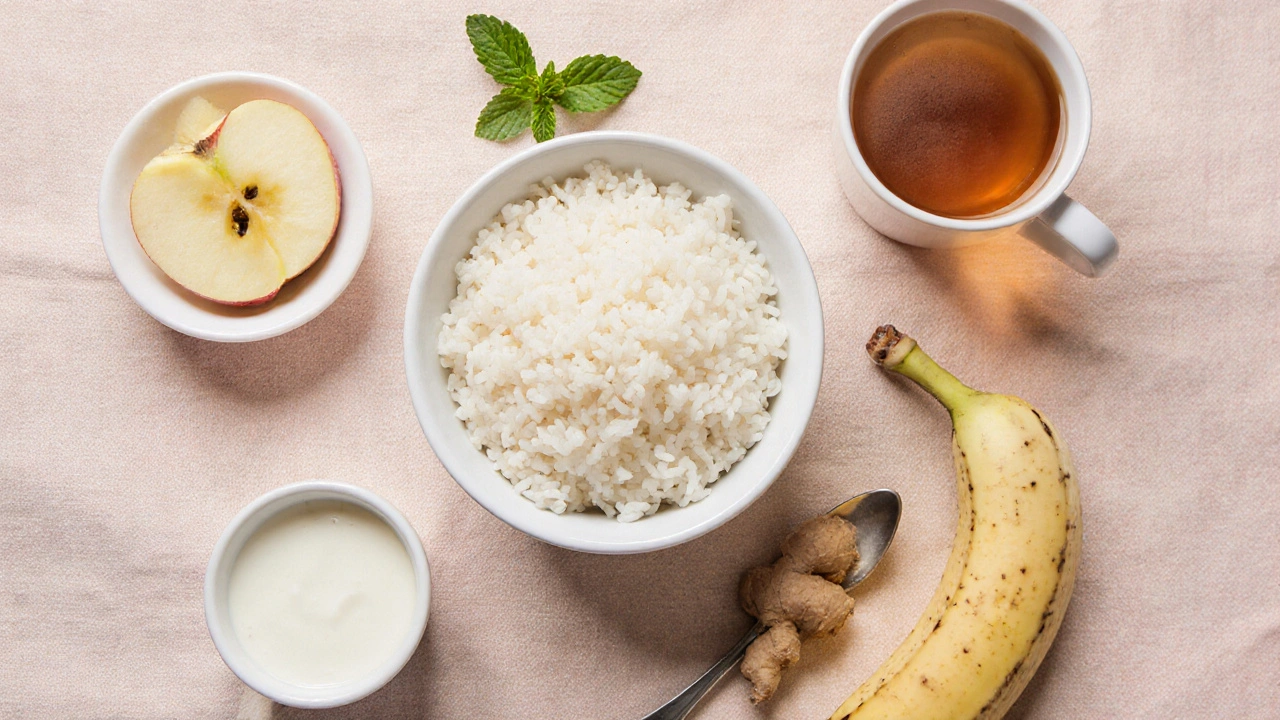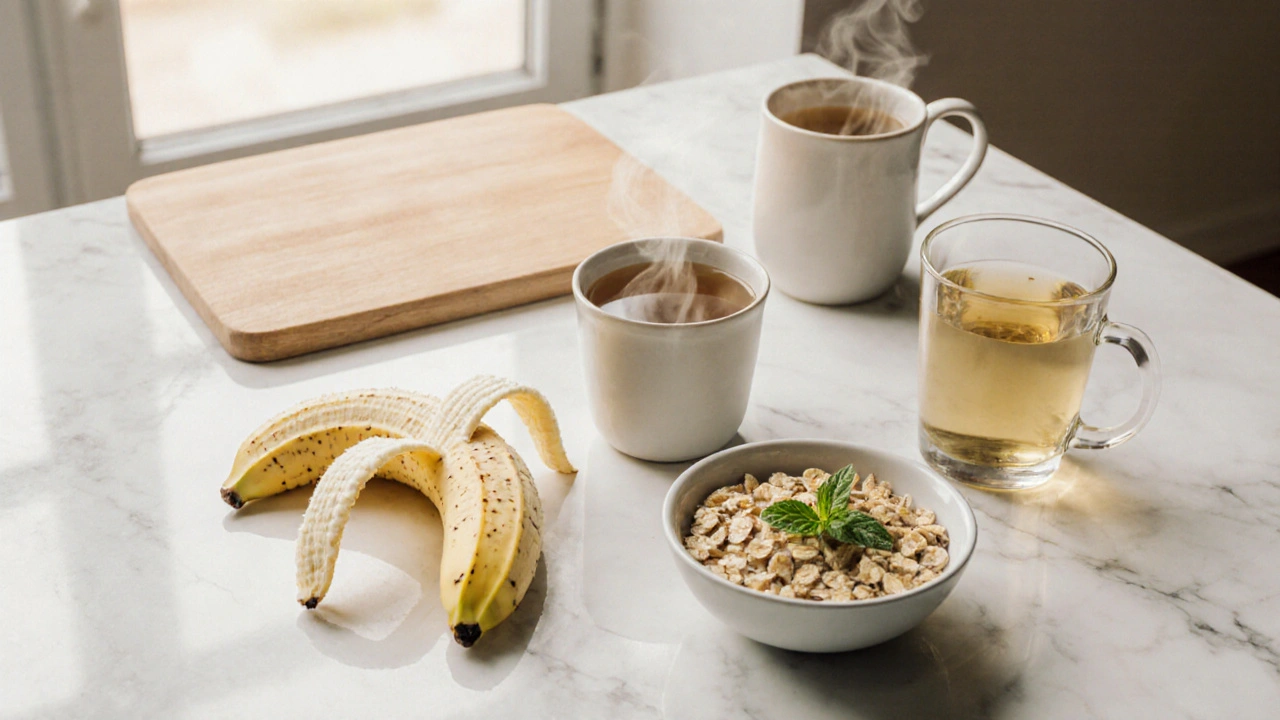Upset Stomach Food Checker
Best Foods to Eat
Bananas
BestLow-fiber, potassium-rich, eases diarrhea
White Rice
BestBland carbs, gentle on the lining
Oatmeal
BestSoluble fiber absorbs excess acid
Ginger Tea
BestAnti-nausea, relaxes stomach muscles
Peppermint Tea
BestRelaxes GI smooth muscle, reduces cramping
Chicken Broth
BestHydrates, provides mild protein without fat
Worst Foods to Avoid
Dairy Products
WorstLactose can cause gas and bloating during upset
Spicy Sauces
WorstIncrease stomach acid, irritate lining
Fried Foods
WorstHigh fat delays gastric emptying, worsens nausea
Caffeine
WorstStimulates acid production, can trigger reflux
Alcohol
WorstIrritates mucosa, causes dehydration
Key Takeaways
- Stick to bland, low‑fiber, low‑fat foods like bananas, white rice, oatmeal and plain yogurt to calm an irritated gut.
- Avoid dairy, spicy sauces, fried foods, caffeine and alcohol until symptoms settle.
- Hydration matters - sip clear broths or herbal teas (ginger, peppermint) in small amounts.
- Eat small, frequent meals rather than large portions.
- If pain persists beyond 48hours or is severe, see a healthcare professional.
Why Food Matters When Your Stomach Is Upset
Your digestive system reacts quickly to what you put on the plate. Certain foods can soothe inflammation, balance stomach acid and keep the gut lining stable, while others aggravate muscle contractions, increase acid output, or trigger gas. Understanding the biological impact helps you make choices that speed up recovery rather than slow it down.

Best Foods to Eat
Below are the top gentle options, each described with a short attribute list.
- Bananas are a low‑fiber, potassium‑rich fruit that’s easy on the stomach and can help firm up loose stools.
- White rice provides bland, easily digestible carbohydrates that give energy without adding bulk.
- Oatmeal (plain, cooked with water) offers soluble fiber that can absorb excess acid and ease nausea.
- Ginger has anti‑nausea properties; sipping ginger tea or chewing a small slice can reduce queasiness.
- Peppermint tea relaxes the smooth muscle of the gastrointestinal tract, helping to relieve cramping.
- Chicken broth provides fluids, electrolytes and a mild protein source without heavy fats.
- Applesauce (unsweetened) supplies a small amount of pectin that can bulk up stool without irritating the lining.
- Plain yogurt contains probiotic cultures that may rebalance gut bacteria, but choose low‑fat varieties without added sugar.
These foods share three core traits: low fat, low spice, and modest fiber. They also supply essential nutrients (potassium, electrolytes, easy carbs) that keep you hydrated and energized while your gut heals.
Worst Foods to Avoid
Now the opposite side - foods that tend to worsen nausea, diarrhea, bloating or acid reflux.
- Dairy products (milk, cheese, ice cream) contain lactose, which many adults struggle to digest during an upset stomach, leading to gas and cramping.
- Spicy foods (chili, hot sauces, curries) trigger excess stomach acid and can inflame the lining further.
- Fried or fatty foods (french fries, burger patties) delay gastric emptying, keeping food in the stomach longer and worsening nausea.
- Caffeine (coffee, energy drinks) stimulates acid production and can increase heartburn.
- Alcohol irritates the mucosal lining and dehydrates you, slowing recovery.
These items typically share high fat, high spice, or high acidity - all of which can aggravate an already sensitive gut.
Sample 24‑Hour Gentle Meal Plan
- Upon waking, sip a cup of warm upset stomach foods - peppermint tea or ginger tea - in 5‑minute intervals.
- Breakfast: half a banana mashed with a tablespoon of plain yogurt. If you’re still hungry, a small bowl of oatmeal cooked in water.
- Mid‑morning snack: a few crackers with a cup of clear chicken broth.
- Lunch: a serving of white rice topped with a spoonful of applesauce and a drizzle of low‑sodium broth.
- Afternoon: another cup of ginger tea, plus a soft‑boiled egg (optional protein) if you feel up to it.
- Dinner: a small portion of plain boiled chicken (no skin) with a side of steamed carrots and a cup of warm broth.
- Before bed: a warm glass of water with a pinch of ginger powder, or a mild chamomile tea if you prefer.
Adjust portion sizes based on how you feel. The goal is to keep calories modest while still delivering electrolytes and a bit of protein.

Tips to Soothe an Upset Stomach Beyond Food
- Stay upright for at least an hour after eating; lying down can promote reflux.
- Drink fluids slowly - a sip every few minutes - to avoid over‑filling the stomach.
- Avoid chewing gum or smoking, both of which can swallow air and increase bloating.
- Apply a warm compress or heating pad to the abdomen for 15‑minute intervals to ease muscle spasms.
- Practice gentle breathing or short walks to stimulate digestion without strenuous activity.
When to Seek Professional Help
If any of the following occur, you should consult a doctor or gastroenterologist:
- Severe, persistent abdominal pain lasting more than 48hours.
- Bloody or black stools, indicating possible bleeding.
- High fever (≥38.5°C) accompanying GI symptoms.
- Inability to keep any liquids down for more than 12hours.
- Signs of dehydration - dry mouth, dizziness, reduced urine output.
These signs may point to infections, ulcers, gallstones or other conditions that need medical treatment.
| Food | Category | Why It Helps or Hurts |
|---|---|---|
| Bananas | Best | Low‑fiber, potassium‑rich, eases diarrhea |
| White rice | Best | Bland carbs, gentle on the lining |
| Oatmeal | Best | Soluble fiber absorbs excess acid |
| Ginger tea | Best | Anti‑nausea, relaxes stomach muscles |
| Peppermint tea | Best | Relaxes GI smooth muscle, reduces cramping |
| Chicken broth | Best | Hydrates, provides mild protein without fat |
| Dairy (milk, cheese) | Worst | Lactose can cause gas and bloating during upset |
| Spicy sauces | Worst | Increase stomach acid, irritate lining |
| Fried foods | Worst | High fat delays gastric emptying, worsens nausea |
| Caffeine | Worst | Stimulates acid production, can trigger reflux |
| Alcohol | Worst | Irritates mucosa, causes dehydration |
Frequently Asked Questions
Can I eat fruit other than bananas?
Yes, but choose low‑acid options like ripe peaches or melons. Citrus fruits (orange, grapefruit) are high in acid and can worsen heartburn.
Is it okay to take over‑the‑counter antacids?
Short‑term use is fine for acid‑related discomfort, but they don’t treat the underlying cause. If you need them for more than a few days, check with a doctor.
Should I avoid fiber completely?
During acute diarrhea, limit insoluble fiber (whole grains, raw vegetables). Soluble fiber (oatmeal, applesauce) can actually help by forming a gel that slows transit.
How much water should I drink?
Aim for 1.5-2liters per day, sipping slowly. If you have vomiting, replace lost electrolytes with oral rehydration solutions or broth.
Can probiotics help?
Plain, low‑fat yogurt with live cultures can repopulate good bacteria, especially after a bout of diarrhea. Choose versions without added sugar or fruit chunks.

Yo, this list is pretty much the gospel for anyone with a queasy gut, but lemme tell you, tossing in any fancy spice is like throwing a match on a gasoline fire-totally dumb move. Stick to the bland stuff or you’ll be paying the price, trust me.